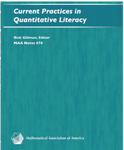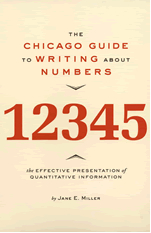Books and Articles
supporting
Quantitative Literacy, Mathematics Across the Curriculum and Ethnomathematics
Text
Langkamp, G and Joe Hull. Quantitative Reasoning and the Environment: Mathematical Modeling in Context. Upper Saddle River, NJ.: Pearson Prentice Hall, 2007.
This well researched new mathematics text teaches essential numeracy, function modeling, difference equation modeling and elementary statistics in the context of over 300 environmental science applications.

Table of contents at: http://www.enviromath.com.
Quantitative Literacy Resource
Gillman, Richard, ed. Current Practices in Quantitative Literacy. at press, Mathematical Association of America.

This series of articles presents a wide sampling of efforts being made on campuses across the country.
Writing and Numeracy
Miller, Jane E. The Chicago Guide to Writing about Number: the Effective Presentation of Quantitative Information. Chicago, IL.: The University of Chicago Press, 2004.

Recommended for those wanting to teach about writing and quantitative literacy.
Quantitative Literacy Issues and Practices
Peer Review: Emerging Trends and Key Debates in Undergraduate Education published a special issue on “Quantitative Literacy” for their summer 2004 issue.
A wonderful primer for quickly learning about analysis and practice of quantitative literacy.
Teaching Sociology, a journal of the American Sociological Association published a “Special Issue on Cultivating Quantitative Literacy” for their January, 2006 issue. Articles include:
- “Cultivating Quantitative Literacy: The Role of Sociology.” - Stephen Sweet and Kerry Strand.
- “Integrating Data Analysis: Working with Sociology Departments to Address the Quantitative Literacy Gap.” – Carla Howery and Havidan Rodriguez.
For more information on these and other QL articles see Volume 34 Number 1: http://www.lemoyne.edu/ts/tscontents.html
Jordan, Jay and Beth Haines. “The Role of Statistics Educators in the Quantitative Literacy Movement.” Journal of Statistics Education Vol. 14, No. 2 (2006),
Entire article is online: http://www.amstat.org/publications/jse/v14n2/jordan.html
Mathematics Texts Emphasizing Quantitative Literacy
- Bennett, Jeffrey and William Briggs. Using and Understanding Mathematics, A Quantitative Reasoning Approach. Menlo Park, CA: Addison-Wesley, 2004.
- Greenleaf, Frederick P. Quantitative Reasoning, Understanding the Mathematical Patterns in Nature. Columbus, OH: McGraw-Hill, 1997.
- Greenleaf, Frederick P. Workshop Projects t/a Quantitative Reasoning. Columbus, OH.: McGraw-Hill, 1997.
- Langkamp, G and Joe Hull. Quantitative Reasoning and the Environment: Mathematical Modeling in Context. Upper Saddle River, NJ.: Pearson Prentice Hall, 2007.
- For All Practical Purposes. COMAP. 2002
- Ritchhart, Ron. Making Numbers Make Sense. A Sourcebook for Developing Numeracy. Menlo Park, CA: Addison-Wesley, 1994.
- Sevilla, Alicia and Kay Somers. Quantitative Reasoning: Tools for Today’s Informed Citizen. Emeryville, CA: Key College Pub., 2007.
General Support of Quantitative Literacy
- Brakke, David F. and David C. Carothers. “Mulitiple Approaches to Improving Quantitative Skills at James Madison University.” Peer Review. 6:4 (Summer 2004): 19-21.
- Diefenderfer, Caren L., Ruth Alden Doan, and Christina Salowey. “The Quantitative Reasoning Program at Hollins University.” Peer Review. 6:4 (Summer 2004): 13-15.
- Jordan, Joy and Beth Haines. “Fostering Quantitative Literacy: Clarifying Goals, Assessing Student Progress.” Peer Review 5:4 (Summer 2003): 16-19.
- Madison, Bernard L and Lynn Steen, eds. Quantitative Literacy: Why Numeracy Matters for Schools and Colleges. Princeton, NJ. NCED, 2003.
- Madison, Bernard L. “Two Mathematics: Ever the Twain Shall Meet.” Peer Review. 6:4 (Summer 2004): 9-12.
- Moses, Robert P. and Charles E. Cobb, Jr. Radical Equations: Organizing Math Literacy in America's Schools. Boston, MA: Beacon Press, 2001.
- Martin, Hope and Long, Madeleine J. Integrating Mathematics across the Curriculum, Vol. 1. Arlington Heights, IL: SkyLight Professional Development, 1996.
- Paulos, John Allen. Beyond Numeracy: Ruminations of a Numbers Man. New York: Vintage, 1992.
- ---. Innumeracy: Mathematical Illiteracy and its Consequences. New York: Vintage, 1988.
- ---. Once Upon A Number: The Hidden Mathematical Logic of Stories. New York: Basic, 1998.
- Schneider, Carol Geary. “Setting Greater Expectations for Quantitative Learning.” Peer Review. 6:4 (Summer 2004): 26-27.
- Steen, Lynn Arthur,ed. Why Numbers Count: Quantitative Literacy for Tomorrow's America. New York, NY: CEEB, 1997.
- Steen, Lynn Arthur, ed. Mathematics and Democracy. The Case for Quantitative Literacy. Princeton, NJ: NCED, 2001.
- ---. Achieving Quantitative Literacy: An Urgent Challenge for Higher Education. Princeton, NJ: NCED, 2001.
- ---. “Everything I Needed to Know about Averages . . . I Learned in College.” Peer Review. 6:4 (Summer 2004): 4-8.
- Wolfe, Christopher R. "Quantitative Reasoning Across a College Curriculum." College Teaching 41:1 (Winter 1993): 3-9.
Mathematics with Reading and/or Writing
- Connolly, Paul, and Teresa Vilardi, eds., Writing to Learn Mathematics and Sciences. New York: Teachers College Press, Columbia University, 1989.
- Franco, Betsy. Math Poetry: Linking Language and Math in a Fresh Way. Tucson, AZ: Goodyear Books, 2006.
- Ganguli, Aparna. "Integrating Writing in Developmental Mathematics College Teaching." College Teaching 37 (1989): 140-142.
- Meier, John and Thomas Rishel. Writing in the Teaching and Learning of Mathematics. Washington, D.C.: The Mathematical Association of America, 1998.
- Miller, Jane E. The Chicago Guide to Writing about Number: the Effective Presentation of Quantitative Information. Chicago, IL: The University of Chicago Press, 2004.
- Mower, Pat. Algebra Outloud: Learning Mathematics Through Reading and Writing Activities. Hoboken, NJ: John Wiley & Sons, Inc, 2003.
- Sterrett, Andrew. Using Writing to Teach Mathematics. MAA Notes 16. Washington, DC: Mathematical Association of America, 1990.
- Tufte, Edward R. Envisioning Information Cheshire, CT: Graphics, 1990.
- ---. The Visual Display of Quantitative Information. Cheshire, CT: Graphics, 1983.
- ---. Envisioning Information. Cheshire, CT: Graphics, 1990.
- ---. Visual Explanations:Images and Quantities, Evidence and Narrative. Cheshire, CT: Graphics, 1997.
- ---. Beautiful Evidence. Cheshire, CT: Graphics, 2006.
Statistics, Media and Data Analysis
- Best, Joel. Damned Lies and Statistics: Untangling Numbers from Media, Politicians and Activists. Berkeley, CA: University of California Press, 2001.
- ---. More Damned Lies and Statistics: How Numbers Confuse Public Issues. Berkeley, CA: University of California Press, 2004.
- Garfield, J. and Ahlgren, A. “Student Reactions to Learning About Probability and Statistics: Evaluating the Quantitative Literacy Project,” School Science & Mathematics, 94:2 (1994): 89-95.
- Howery, Carla, and Havidan Rodriguez. “Integrating Data Analysis: Working with Sociology departments to Address the Quantitative Literacy Gap,” Teaching Sociology. 34:1 (2006): 23-38.
- Huff, Darrell and Irving Geis. How to Lie With Statistics. New York: WW Norton & Company, 1982.
- Jordan, Jay and Beth Haines. “The Role of Statistics Educators in the Quantitative Literacy Movement.” Journal of Statistics Education 14:2 (2006). http://www.amstat.org/publications/jse/v14n2/jordan.html.
- Paxton, Pamela. “Dollars and Sense: Convincing Students That They Can Learn and Want to Learn Statistics,” Teaching Sociology. 34:1 (2006): 65-70.
- Paulos, John Allen. A Mathematician Reads the Newspaper. New York: Anchor, 1996.
- Shield, Milo. “Statistical Literacy and Liberal Education at Augsburg College.” Peer Review. 6:4. (Summer 2004): 16-18.
- Utts, J. “What Educated Citizens Should Know About Statistics and Probability,” The American Statistician, 57:2 (2003): 74-79.
Mathematics & Quantitative Literacy Across the Disciplines
- Bunt, Lucas N.H. The Historical Roots of Elementary Mathematics. New York: Dover Publications, 1988.
- Caulfield, Susan. “Teaching Social Science Reasoning and Quantitative Literacy: The Role of Collaborative Groups,” Teaching Sociology. 34:1 (2006): 39-53
- Garland, Trudi Hammel. Fascinating Fibonaccis. Mystery and Magic in Numbers. Palo Alto, CA: Dale Seymour, 1987.
- Garland, Trudi Hammel and Kahn, Charity Vaughan. Math and Music: Harmonious Connections. Palo Alto, CA: Dale Seymour, 1995.
- Katz, Victor, ed. Using History to Teach Mathematics; An International Perspective. Washington, DC: MAA, 2000.
- Laminack, Lester L., and Reba M. Wadsworth. Reading Aloud Across the Curriculum: How to Build Bridges in Language Arts, Math, Science and Social Studies. Portsmouth, NH: Heinemann Books, 2006.
- Stewart, Ian. Nature's Numbers: The Unreal Reality of Mathematics. New York, NY: Basic Books, 1995.
- Sweet, Stephen, and Kerry Strand. “Cultivating Quanatitative Literacy: The Role of Sociology,” Teaching Sociology. 34:1 (January 2006): 1-4
Ethnomathematics
- Ascher, Marcia. Ethnomathematics: A Multicultural View of Mathematical Ideas. Pacific Grove, CA.: Brooks/Cole, 1994.
- Ascher, Marcia and Ascher, Robert. Mathematics of the Incas: Code of the Quipu. Mineola, New York: Dover Publications, 1997.
- Closs, Michael P. ed. Native American Mathematics. Austin, TX: University of Texas Press, 1986.
- Eglash, Ron. African Fractals: Modern Computing and Indigenous Design. New Brunswick, N.J.: Rutgers University Press, 1999.
- Gerdes, Paulus. Women, Art, and Geometry in Southern Africa. Trenton, NJ: Africa World Press, 1998.
- Joseph, George Gheverghese. The Crest of the Peacock. London: Penguin Books, 2000.
- Krause, Marina C. Multicultural Mathematics Materials. Reston, VA: National Council of Teachers of Mathematics, 1983.
- Lumpkin, Beatrice. Geometry Activities from Many Cultures. Portland, ME: J. Weston Walch, 1997.
- McLeish, John. The Story of Numbers: How Mathematics Has Shaped Civilization. New York: Fawcett Books, 1994.
- Nelson, David, George Gheverghese Joseph, and Julian Williams. Multicultural Mathematics: Teaching Mathematics from a Global Perspective. New York: Oxford UP. 1993.
- Powell, Arthur B. and Marilyn Frankenstein, eds. Ethnomathematics: Challenging Eurocentrism in Mathematics Education. Albany, NY: State U of New York P, 1997.
- ---. Geometry from Africa : mathematical and educational explorations. Washington, DC: Mathematical Association of America, c1999.
- Zaslavsky, Claudia. Multicultural Mathematics:Interdisciplinary Cooperative-Learning Activities. Portland, Maine: J. Weston Walch, 1999.
- ---. Africa Counts:Number and Pattern in African Culture. Westport, Conn.: Lawrence Hill & Co., 1979.
- ---.The Multicultural Math Classroom: Bringing in the World. Portsmouth, NH: Heinemann, 1995.
Interdisciplinary Teaching and Learning Communities
- Gabelnick, F., J. MacGregor, R. Mathews, and B.L. Smith. Learning Communities: Creating Connections among Students, Faculty and Disciplines. New Directions for Teaching and Learning 41. San Francisco: Jossey, 1990.
- Harnish, Jim. “Students Experience in Coordinated Studies: What Data on Learning Communities Reveals,” Newsletter of the Washington Center for Improving the Quality of Undergraduate Education. (Winter 2006): 23-25.
- MacGregor, Jean, compiler. Strengthening Learning Communities: Case Studies from the National Learning Communities Dissemination Project (FIPSE). Olympia, WA: The Evergreen State College, Washington Center for Improving the Quality of Undergraduate Education, 1999.